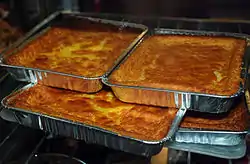Cantabrian cuisine
Cantabrian cuisine includes seafood from the Cantabrian Sea; salmon and trout from the upper basins of the rivers; vegetables and dairy products from the valleys; and veal and game from the Cantabrian mountains.

Fish and seafood


Seafood is widely used, from the entire coast and the Bay of Santander in particular, including clams, mussels, pod razors, cockles, crabs, barnacles, crayfish, snails, lobster, and squid. Fish include sea bass, hake, scorpion fish, anchovy, sardine, and albacore.
The albacore or bonito del norte is used in one of the most typical dishes of the region: marmita or sorropotún. Some of the most renowned Cantabrian dishes are hake in green sauce, squid with onions and squid ink (maganos encebollados), and clam casserole.
Meats
Veal is widely consumed, often from the Tudanca cattle. The National Cattle Fair of Torrelavega, the largest cattle fair in Spain, is held in Cantabria. Game is also of high quality: deer, roe deer, and wild boar. Pork is a key element for the cocido montañés, literally 'mountain stew', with beans, cabbage, and other ingredients.
Pastry
Cantabrian pastries include the traditional sobaos and quesada pasiega. Puff pastry is widely used, with different names in different regions: corbatas in Unquera and San Vicente de la Barquera, polkas in Torrelavega, and sacristanes in Liérganes. Other notables sweets are frisuelos and canónigos, both of Liébana; corazones of Liérganes, the palucos of Cabezón de la Sal; and the tortos and pantortillas of Reinosa. Other desserts not of Cantabrian origin are rice pudding, natillas, leche frita, and fruit jams.
Dairy products include Cantabrian cream cheese; picón Bejes-Tresviso in Tresviso and its neighboring town; smoked cheeses (named for specific places) such as Áliva or Pido; and the Quesucos de Liébana, made with a mixture of cow and sheep milk.
Alcoholic beverages
Orujo is the Cantabrian pomace brandy. Historically, cider and chacoli or txakoli wine were a specialty;[1][2] after a major and long-term decline, they are recovering.
Two Spanish wines (vinos de la tierra) with denominación de origen calificada (protected geographical status) from Canabria are Costa de Cantabria and Liébana, named after the localities of their production.
References
- Barreda, Fernando; The Chacoli Santander in the 13th to 19th centuries; 1947 (1st reprint edition, 2001); Maxtor Editorial Library; ISBN 84-95636-84-0.
- "In fact, chacoli until the late 19th century a widespread product in the Cantabrian, and half a century and the production of the province of Santander-today, autonomous community of Cantabria, quite widely exceeded that of the Basque provinces, according to data collected Huetz Professor of Bordeaux Alain Lemps in his landmark study Vignobles et vins du Nord-Ouest de l'Espagne." "The txakoli of Burgos Valle de Mena wants OJ" (2005), elmundovino.elmundo.es; retrieved 19 January 2008.